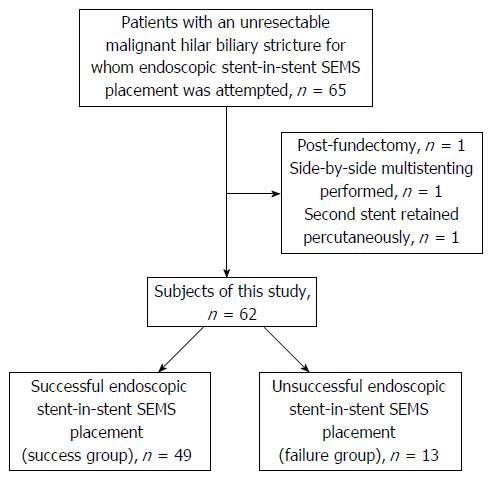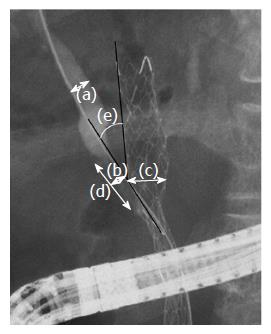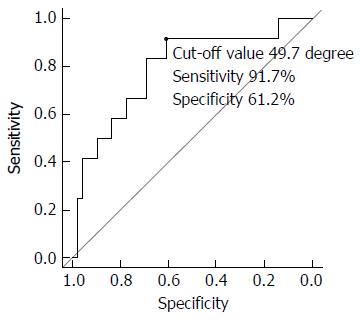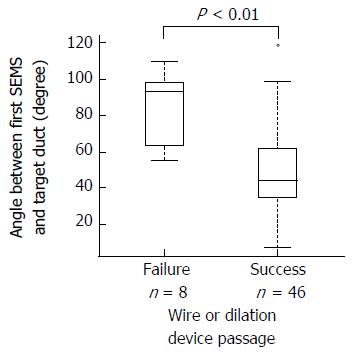Copyright
©The Author(s) 2017.
World J Gastroenterol. Sep 14, 2017; 23(34): 6273-6280
Published online Sep 14, 2017. doi: 10.3748/wjg.v23.i34.6273
Published online Sep 14, 2017. doi: 10.3748/wjg.v23.i34.6273
Figure 1 Targets of this study.
Among 65 patients with an unresectable malignant hilar biliary obstruction, 62 patients were included. These 62 patients were divided into two groups, the success group, in whom an endoscopic stent-in-stent self-expandable metallic stent (SEMS) placement was successful, and the failure group, in whom an endoscopic stent-in-stent SEMS placement was unsuccessful.
Figure 2 Endoscopic retrograde cholangiography image showing the details of the obstructive state of the biliary duct.
We evaluated the obstructive state of the biliary duct by measuring the following four items: (a) The diameter of the target biliary duct, (b) the diameter of the target biliary stricture, (c) the diameter of the first retained self-expandable metallic stent (SEMS), (d) the length of the target biliary duct stricture and (e) the angle between the target biliary duct stricture and the first implanted SEMS.
Figure 3 ROC curve of the angle between the target biliary duct stricture and the first implanted self-expandable metallic stent.
A cut-off value of 49.7 degrees with a sensitivity of 91.7% and a specificity of 61.2% can be used to predict stent-in-stent self-expandable metallic stent placement failure.
Figure 4 Influence of the angle between the target biliary duct stricture and the first retained self-expandable metallic stent on wire or dilation device passage.
The angle between the target biliary stricture and the first implanted self-expandable metallic stent in patients without wire or dilation catheter passage was significantly greater than the corresponding angle in the patients with wire or dilation catheter passage [93.0 degree (55-109.3) vs 44.2 degree (7-119.0), P < 0.01, median (range)].
- Citation: Sugimoto M, Takagi T, Suzuki R, Konno N, Asama H, Watanabe K, Nakamura J, Kikuchi H, Waragai Y, Takasumi M, Sato Y, Hikichi T, Ohira H. Predictive factors for the failure of endoscopic stent-in-stent self-expandable metallic stent placement to treat malignant hilar biliary obstruction. World J Gastroenterol 2017; 23(34): 6273-6280
- URL: https://www.wjgnet.com/1007-9327/full/v23/i34/6273.htm
- DOI: https://dx.doi.org/10.3748/wjg.v23.i34.6273












